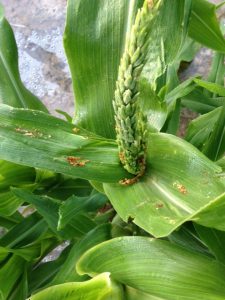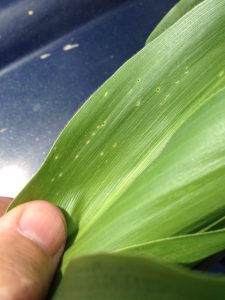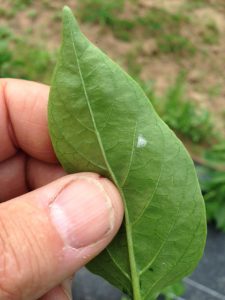Sweet Corn
European corn borer (ECB) moth captures are fairly steady at low levels in northern and central county light traps. Feeding has been detected in some whorl and pretassel stage plantings where scouting is occurring. Thus far, feeding has been mostly in single digit percentages, although one planting in Somerset County approached 20% plants infested. Feeding may be expected to rise modestly over the next two weeks. Whorl corn is the primary target for egg laying. Feeding may be present at higher numbers in the southern counties.
 Look for the characteristic “shot-hole” type of feeding (photo below at right) and consider treating when infested plants exceed 12% in a 50 plant sample. As plantings proceed to the pre-tassel stage, ECB larvae may be found in emerging tassels (see photo at left). It is a good idea to treat individual plantings as they move into the full tassel/first silk stage one time. This eliminates any ECB larvae that have emerged with the tassels as they begin to move down the stalk to re-enter near developing ears.
Look for the characteristic “shot-hole” type of feeding (photo below at right) and consider treating when infested plants exceed 12% in a 50 plant sample. As plantings proceed to the pre-tassel stage, ECB larvae may be found in emerging tassels (see photo at left). It is a good idea to treat individual plantings as they move into the full tassel/first silk stage one time. This eliminates any ECB larvae that have emerged with the tassels as they begin to move down the stalk to re-enter near developing ears.
Useful insecticides for this particular application include synthetic  pyrethroids (IRAC Grp 3), spinosyns (including OMRI approved Entrust) IRAC Grp 5), and diamides such as Coragen or Vantacor (IRAC Grp 28) or materials such as Besiege which include the active ingredient in Coragen. It should be noted that Coragen or Vantacor, used alone, are not toxic to bees that may be visiting corn tassels during this stage. Synthetic pyrethroids alone should NOT be used for corn earworm (CEW) protection on silking corn. Control with these materials is very inconsistent.
pyrethroids (IRAC Grp 3), spinosyns (including OMRI approved Entrust) IRAC Grp 5), and diamides such as Coragen or Vantacor (IRAC Grp 28) or materials such as Besiege which include the active ingredient in Coragen. It should be noted that Coragen or Vantacor, used alone, are not toxic to bees that may be visiting corn tassels during this stage. Synthetic pyrethroids alone should NOT be used for corn earworm (CEW) protection on silking corn. Control with these materials is very inconsistent.
The highest nightly trap catches of ECB for the week ending 6/05/24 are as follows:
| Asbury 1 | Lawrenceville 1 |
| Clinton 1 | Milford 1 |
| Dayton 1 | Oldwick 1 |
| Georgetown 1 | Princeton 1 |
| Hillsborough 1 | South Branch 1 |
Corn earworm (CEW) moths continue to be captured in blacklight traps in the northern and central counties. Numbers are low but steady. This population will threaten corn early plantings are now beginning to silk in many areas. While data from the pheromone trap network in southern NJ is not yet available, northern traps are recording modest numbers. For these early silking plantings, even low CEW numbers will be impactful. Be sure to access information from this publication in the upcoming weeks to determine how frequently you must treat silking sweet corn to protect it from CEW infestation.
The highest nightly blacklight trap catches of CEW for the week ending 6/05/24 are as follows:
| Asbury 1 | South Branch 1 |
| Bellemeade 1 | |
| Hillsborough 1 | |
| Milltown 1 |
The highest nightly pheromone trap catches of CEW for the week ending 6/05/24 are as follows:
| Allamuchy 4 | Dayton 2 | Milford 1 |
| Bellemeade 4 | Georgetown 2 | Pennington 1 |
| Farmingdale 4 | Hackettstown 1 | Sparta 1 |
| Califon 2 | Matawan 1 | South Branch 1 |
Silking Spray Schedules*:
South – 4 days
Central – 4-5 days
North – 5 days
*These recommendations are ESTIMATES, due to insufficient data from southern NJ . Adhere to tighter spray schedules if indicated by local trap catches. Synthetic pyrethroids alone should NOT be used for corn earworm (CEW) protection on silking corn. Control with these materials is very inconsistent.
Peppers
 With modest increases in ECB moth activity over the next few weeks, growers should be looking for ECB egg masses (see photo at left) on the underside of pepper leaves. The larvae that hatch from these eggs will bore into the central stem of pepper plants in the absence of suitable fruit. This damage causes the tops of the plant to die, and eliminating the crown set of fruit in the process. Check 2 leaves per plant on 5 consecutive plants in 10 random locations. Consider treating if 2 or more leaves are found to have ECB larvae on the lower surface.
With modest increases in ECB moth activity over the next few weeks, growers should be looking for ECB egg masses (see photo at left) on the underside of pepper leaves. The larvae that hatch from these eggs will bore into the central stem of pepper plants in the absence of suitable fruit. This damage causes the tops of the plant to die, and eliminating the crown set of fruit in the process. Check 2 leaves per plant on 5 consecutive plants in 10 random locations. Consider treating if 2 or more leaves are found to have ECB larvae on the lower surface.

